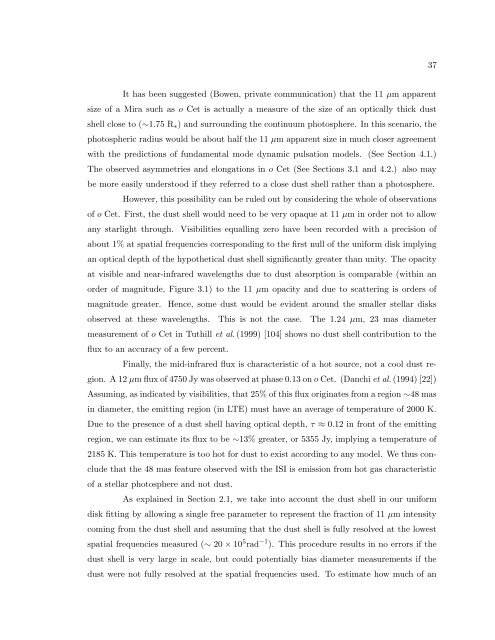The Size, Structure, and Variability of Late-Type Stars Measured ...
The Size, Structure, and Variability of Late-Type Stars Measured ...
The Size, Structure, and Variability of Late-Type Stars Measured ...
Create successful ePaper yourself
Turn your PDF publications into a flip-book with our unique Google optimized e-Paper software.
37<br />
It has been suggested (Bowen, private communication) that the 11 µm apparent<br />
size <strong>of</strong> a Mira such as o Cet is actually a measure <strong>of</strong> the size <strong>of</strong> an optically thick dust<br />
shell close to (∼1.75 R ∗ ) <strong>and</strong> surrounding the continuum photosphere. In this scenario, the<br />
photospheric radius would be about half the 11 µm apparent size in much closer agreement<br />
with the predictions <strong>of</strong> fundamental mode dynamic pulsation models. (See Section 4.1.)<br />
<strong>The</strong> observed asymmetries <strong>and</strong> elongations in o Cet (See Sections 3.1 <strong>and</strong> 4.2.) also may<br />
be more easily understood if they referred to a close dust shell rather than a photosphere.<br />
However, this possibility can be ruled out by considering the whole <strong>of</strong> observations<br />
<strong>of</strong> o Cet. First, the dust shell would need to be very opaque at 11 µm in order not to allow<br />
any starlight through. Visibilities equalling zero have been recorded with a precision <strong>of</strong><br />
about 1% at spatial frequencies corresponding to the first null <strong>of</strong> the uniform disk implying<br />
an optical depth <strong>of</strong> the hypothetical dust shell significantly greater than unity. <strong>The</strong> opacity<br />
at visible <strong>and</strong> near-infrared wavelengths due to dust absorption is comparable (within an<br />
order <strong>of</strong> magnitude, Figure 3.1) to the 11 µm opacity <strong>and</strong> due to scattering is orders <strong>of</strong><br />
magnitude greater. Hence, some dust would be evident around the smaller stellar disks<br />
observed at these wavelengths. This is not the case. <strong>The</strong> 1.24 µm, 23 mas diameter<br />
measurement <strong>of</strong> o Cet in Tuthill et al. (1999) [104] shows no dust shell contribution to the<br />
flux to an accuracy <strong>of</strong> a few percent.<br />
Finally, the mid-infrared flux is characteristic <strong>of</strong> a hot source, not a cool dust region.<br />
A 12 µm flux <strong>of</strong> 4750 Jy was observed at phase 0.13 on o Cet. (Danchi et al. (1994) [22])<br />
Assuming, as indicated by visibilities, that 25% <strong>of</strong> this flux originates from a region ∼48 mas<br />
in diameter, the emitting region (in LTE) must have an average <strong>of</strong> temperature <strong>of</strong> 2000 K.<br />
Due to the presence <strong>of</strong> a dust shell having optical depth, τ ≈ 0.12 in front <strong>of</strong> the emitting<br />
region, we can estimate its flux to be ∼13% greater, or 5355 Jy, implying a temperature <strong>of</strong><br />
2185 K. This temperature is too hot for dust to exist according to any model. We thus conclude<br />
that the 48 mas feature observed with the ISI is emission from hot gas characteristic<br />
<strong>of</strong> a stellar photosphere <strong>and</strong> not dust.<br />
As explained in Section 2.1, we take into account the dust shell in our uniform<br />
disk fitting by allowing a single free parameter to represent the fraction <strong>of</strong> 11 µm intensity<br />
coming from the dust shell <strong>and</strong> assuming that the dust shell is fully resolved at the lowest<br />
spatial frequencies measured (∼ 20 × 10 5 rad −1 ). This procedure results in no errors if the<br />
dust shell is very large in scale, but could potentially bias diameter measurements if the<br />
dust were not fully resolved at the spatial frequencies used. To estimate how much <strong>of</strong> an













![Problem #1 [Structure Formation I: Radiation Era]](https://img.yumpu.com/37147371/1/190x245/problem-1-structure-formation-i-radiation-era.jpg?quality=85)


